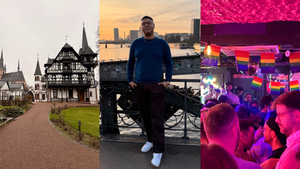
CONTACTAbout UsCAREER OPPORTUNITIESADVERTISE WITH USPRIVACY POLICYPRIVACY PREFERENCESTERMS OF USELEGAL NOTICE
© 2025 Equal Entertainment LLC.
All Rights reserved
All Rights reserved
By continuing to use our site, you agree to our Privacy Policy and Terms of Use.
We need your help
Your support makes The Advocate's original LGBTQ+ reporting possible. Become a member today to help us continue this work.
Your support makes The Advocate's original LGBTQ+ reporting possible. Become a member today to help us continue this work.
I have been struck lately by the ubiquity of media in New York from the early part of the AIDS crisis. In the span of three months, ACT UP had a successful summer exhibition at the White Cube Gallery, the Actors Fund staged Larry Kramer's play The Normal Heart as a reading, and Tony Kushner's play Angels in America reopened just this past week. The AIDS-era history is reentering the communities' consciousness and reaching a new, young gay audience.
These renewed dialogues are important, as evidenced by troubling statistics that one in five gay men in urban areas are living with HIV. The revivals and exhibitions are initiating conversations between gay New Yorkers who lived through the crisis and those who either moved here or were born after it began. We return to these plays and organizations, many of which are older than some of the gay men newly affected by HIV, because they are effective at making the news media and the government pay attention to a crisis they would have rather ignored.
However, we appear to face a continued problem in getting the news media and government to pay attention to the issue of HIV and AIDS as it affects the gay community. Following reports of successful trials in women of vaginal microbicides at the international HIV/AIDS summit this summer, numerous publications lauded the findings as a breakthrough in the fight against the disease. While the American media reported extensively on the findings of the study in women, news outlets made little or no allusion to the potential application of the treatment in HIV prevention among gay men. Considering that the population most affected by HIV and AIDS in the United States is men who have sex with men, how can this not be an important issue for the American media to consider?
Clearly, researchers are developing vaginal microbicides to stem the international AIDS epidemic, which affects many more millions in Africa than in the U.S. The microbicides in development are not effective enough to replace condoms as the most viable preventive measure and are currently only being tested for use in developing countries. One could argue that the American news media coverage only reflects these realities.
However, in considering advancements in international HIV prevention, it may be possible to see how national policy will be formulated as well. An October 25 announcement from the Food and Drug Administration and the CONRAD research institute declared that a vaginal microbicide will be fast-tracked for approval for use as a preventive tool against HIV. As American-led international bodies begin planning to manufacture and distribute vaginal microbicides, the Centers for Disease Control and Prevention has yet to finish trials to determine the treatment's potential efficacy for gay men. The only study that the CDC has completed involving gay men and rectally administered microbicides determined that long-term use of the treatment does not seem to cause any physical harm. The study concluded nothing regarding the effectiveness of the treatment in preventing HIV in gay men.
The efficacy of rectal microbicides will not be known until the completion of the study. Regardless, microbicides seem to be the most important recent advancement in fighting HIV infection. The fact that FDA approval has already been announced for heterosexual use, but no report has yet to be released regarding potential efficacy in men who have sex with men, is reason for concern. This process demonstrates that new HIV treatments are being developed for heterosexuals first and have not been simultaneously tested in gay men.
The troubling rise in HIV cases among urban gay men should be evidence enough that drastic changes in policy and increased funding for awareness, treatment, and prevention are imminently necessary. On the one hand, I am disappointed with the news media and the government for not taking more action on our behalf. However, I cannot say that it is surprising, given the history of the AIDS crisis in the United States, that we must continue to fight and advocate for ourselves in order to be heard. In revisiting the stories and histories of the crisis, activists and forebears are sharing their knowledge and experiences with a new generation of gay men and women. The recent revivals and reexaminations of the initial fight against HIV and AIDS will, I hope, inspire a new generation of activists to continue the fight against HIV in our community and against indifference from our society.
From our Sponsors
Most Popular
Bizarre Epstein files reference to Trump, Putin, and oral sex with ‘Bubba’ draws scrutiny in Congress
November 14 2025 4:08 PM
True
Jeffrey Epstein’s brother says the ‘Bubba’ mentioned in Trump oral sex email is not Bill Clinton
November 16 2025 9:15 AM
True
Gay makeup artist Andry Hernández Romero describes horrific sexual & physical abuse at CECOT in El Salvador
July 24 2025 10:11 AM
True
Watch Now: Pride Today
Latest Stories
Democratic officials sue RFK Jr. over attempt to limit gender-affirming care for trans youth
December 24 2025 4:30 PM
Heated Rivalry season 2: Everything we know so far
December 24 2025 3:30 PM
Lillian Bonsignore will be first out gay Fire Department of New York commissioner
December 23 2025 6:21 PM
The HIV response on a cliff-edge: advocacy must drive urgent action to end the epidemic
December 23 2025 2:23 PM
CECOT story pulled by Bari Weiss gets viewed anyway thanks to Canadian streaming service
December 23 2025 2:05 PM
Burkina Faso issues first sentence for 'homosexuality and related practices'
December 23 2025 2:02 PM
Transgender NSA employee files discrimination lawsuit against Trump administration
December 23 2025 12:03 PM
Billy Porter is set to make a 'full recovery' from sepsis
December 23 2025 11:54 AM
Soccer stars Rafaelle Souza and Halie Mace are engaged & the video is so adorable
December 23 2025 10:52 AM
What is 'hopecore' and how can it make life better for LGBTQ+ people?
December 23 2025 10:00 AM
Santa Speedo Run 2025: See 51 naughty pics of the festive fundraiser
December 23 2025 6:00 AM
Instructor who gave U of Oklahoma student a zero on anti-trans paper removed from teaching
December 22 2025 9:36 PM
All about the infamous CECOT prison — on which CBS's Bari Weiss pulled a story
December 22 2025 7:27 PM
Chest binder vendors respond to 'absurd' FDA warning letter: 'Clearly discrimination'
December 22 2025 3:16 PM
Gay NYC Council member Erik Bottcher drops U.S. House bid, will run for state Senate instead
December 22 2025 2:03 PM
Massachusetts removes rule requiring foster parents to support LGBTQ+ youth
December 22 2025 12:55 PM
Dave Chappelle defends Saudia Arabia set: Trans jokes 'went over very well'
December 22 2025 12:33 PM
Texas judge who refused to officiate same-sex weddings sues to overturn marriage equality
December 22 2025 11:41 AM



































































Charlie Kirk DID say stoning gay people was the 'perfect law' — and these other heinous quotes